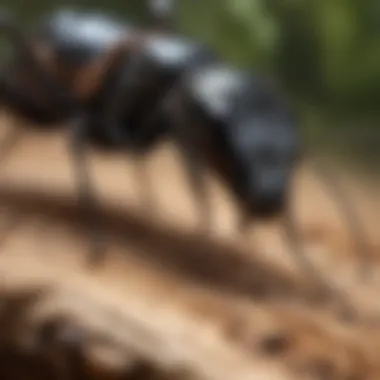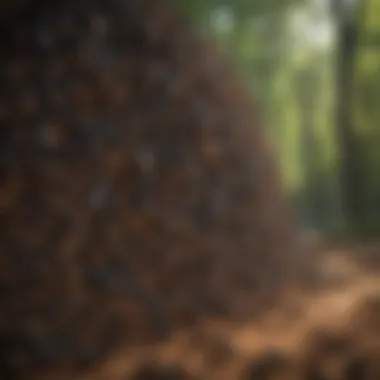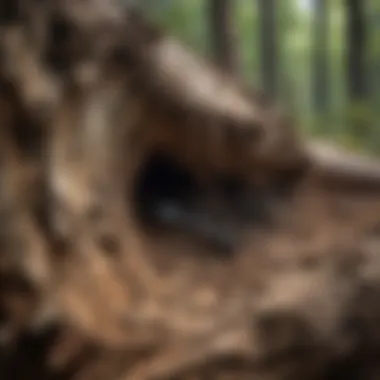Understanding Swarming Behavior in Carpenter Ants


Intro
Carpenter ants are fascinating creatures that play an integral role within their respective ecosystems. Focusing on their swarming behavior reveals much about their social structure and interaction with their environment. This article aims to explore important aspects of carpenter ants, including their life cycle, nesting habits, and ecological impacts in detail. Understanding their dynamics provides insights not only into their behaviors but also into how they affect forest ecosystems and residential areas.
The discussion is designed for forestry professionals and academics, allowing them to appreciate the complexities of these insects. By examining the intersection of entomology and forestry, the article emphasizes the need for informed management strategies to handle carpenter ant populations effectively.
A thorough exploration of the relationship between carpenter ants and the forest environment will be presented, highlighting the significance of these insects and offering practical advice on managing them.
Foreword to Carpenter Ants
Carpenter ants are a fascinating subject in entomology and forestry, serving as a strong indicator of ecosystem health. Understanding these ants provides insights not only into their behavior and biology but also their role within forest ecosystems. This section highlights critical aspects of carpenter ants, focusing on their taxonomy, classification, and physical features. By examining these elements, readers will appreciate their ecological importance and what makes them unique among other ant species. This foundation is pivotal for grasping the complexities of their swarming behavior.
Taxonomy and Classification
Carpenter ants belong to the family Formicidae and are part of the subfamily Formicinae. Their scientific classification places them in the genus Camponotus, which encompasses over 100 species in North America alone. This diverse group can be difficult to identify without proper examination. Specifically, carpenter ants can be distinguished by their size, typically ranging from 1/4 to 1/2 inch. Each species has its own unique characteristics that contribute to its niche in the ecosystem.
Common species include the black carpenter ant, Camponotus herculeanus, and the red carpenter ant, Camponotus vagus. Each species exhibits a range of behaviors and adaptations that allow them to thrive in their specific environments. Such knowledge facilitates better understanding of their lifecycle, nesting habits, and interplay with the ecosystem.
Physical Characteristics
Physical traits of carpenter ants vary slightly across species, yet they share common features that aid identification. One notable characteristic is their robust body structure. Carpenter ants have a smooth, shiny exoskeleton, typically black, reddish, or a combination of colors, depending on the species.
Their mandibles are large and powerful, ideal for digging and foraging. These ants also possess compound eyes, which grant them excellent vision, critical for navigation during foraging. The body is segmented into three sections: head, thorax, and abdomen, which is a common trait among all ants.
Key Characteristics of Carpenter Ants:
- Size: Range from 1/4 to 1/2 inch in length.
- Color: Varied, mostly black or reddish tones.
- Mandibles: Strong, suited for wood excavation.
- Eyes: Prominent, providing sharp vision.
Understanding these physical attributes not only aids in identification but also highlights their functional adaptations in their environment.
Ecological Role of Carpenter Ants
The ecological role of carpenter ants is multifaceted and plays a crucial part in maintaining forest ecosystems. By participating in various processes, they contribute to the health and stability of their habitats. Understanding these roles is essential for forestry professionals and academics who study biodiversity and ecosystem dynamics. Carpenter ants act as decomposers, contributing to nutrient cycling. Their nesting habits create cavities in wood, which can lead to the eventual breakdown of dead trees, facilitating the return of nutrients to the soil. This process supports the growth of other plants and organisms in the ecosystem.
Their roles also extend to influencing the populations of other insects. As predators, adult carpenter ants feed on softer-bodied insects, such as aphids and caterpillars. By doing so, they help keep these populations in check, thus promoting a balanced ecosystem. This predatory behavior contributes to their importance as biological control agents.
Furthermore, carpenter ants are notable for their interactions in mutualistic relationships, particularly with aphids. They protect these sap-sucking insects from predators in exchange for honeydew, a sugary secretion. This interaction illustrates the complexity of food webs and species interactions within forest ecosystems. By fostering these particular relationships, carpenter ants ultimately support both plant and animal communities.
Nesting Habits
Carpenter ants exhibit unique nesting habits that significantly influence their ecological profile. These ants do not actually eat wood but excavate it to create their nests. They prefer damp or decaying wood, which is easier to tunnelling. Within forests, they often utilize dead trees or fallen logs as prime nesting sites.


Carpenter ants form established colonies with multiple nests. A main nest may contain the queen and the majority of workers. Secondary or satellite nests can also exist nearby. This nesting strategy allows them to thrive in varied environments and enables a colony to remain resilient in adverse conditions.
Diet and Foraging Behavior
Carpenter ants are omnivorous, with a diet ranging from sugary substances to protein sources. Their diet often consists of:
- Honeydew from aphids and other sap-sucking insects
- Other insects, which they hunt or scavenge
- Plant materials, including fruits and seeds
When foraging, carpenter ants display a strong social organization. Workers scout for food and communicate with pheromones, marking trails to guide others. This behavior is essential for effective foraging and resource management within their colony. The foraging behavior directly influences local ecosystems. By controlling herbivore populations, they help maintain balance in both plant and animal communities.
Interactions within Forest Ecosystems
The interactions of carpenter ants with other species contribute to their significance in forest ecosystems. They foster a network of relationships ranging from mutualism to predation. Their nest excavations provide habitats for numerous other organisms, including fungi, other insects, and small mammals.
Moreover, their predatory habits aid in regulating insect populations, which can prevent overpopulation of harmful pests. This intricate balance showcases the importance of carpenter ants as integral players in forest health. In many cases, their presence indicates a thriving ecosystem, one where diverse connections sustain life.
Therefore, carpenter ants are not mere isolate species; they embody relationships that define the very fabric of forest ecosystems, reflecting both their ecological importance and the complexity inherent in nature.
Swarming Behavior Explained
Swarming is a significant behavior exhibited by carpenter ants, marking a crucial phase in their life cycle. Understanding the dynamics of a swarm can provide insights into their role in the ecosystem, their reproductive strategies, and how they thrive in various environments. This section focuses on what motivates swarming, the specific conditions that catalyze this behavior, and the detailed processes involved in swarm formation. By grasping these elements, forestry professionals and academics can foster a greater appreciation of carpenter ants' ecological roles.
The Purpose of Swarming
Swarming serves primarily for reproduction and the establishment of new colonies. In carpenter ants, this behavior is critical for genetic diversity and the sustainability of the species. During a swarm, winged males and females, known as alates, leave their nests to engage in a mating flight. The mating process typically occurs mid-air, allowing for gene mixing, which enhances the resilience of future generations.
Moreover, swarming is a tactic to expand territory. Newly mated queens can establish nests away from their birth colonies, reducing competition for resources. This dispersal method ensures a broader distribution of carpenter ants across various habitats, contributing to ecosystem balance.
Timing and Conditions for Swarming
The timing of a swarm is influenced by environmental factors such as temperature, humidity, and seasonal changes. Swarming often occurs in spring and early summer when conditions are favorable for flight. Warm temperatures and adequate moisture help facilitate the insects' activities.
Typically, carpenter ants swarm during the early evening, making it an opportune time for their mating ritual, as temperatures are optimal, and winds are usually calmer. Specific indicators, like the availability of food, also play a role. When food is abundant, it signals to the colony that conditions are right for expansion and reproduction.
Carpenter ants often depend on external cues, focusing on environmental conditions to time their swarming events effectively.
Swarm Formation Process
The formation of a swarm involves several strategic steps. Before swarming begins, the colony prepares by ensuring that a sufficient number of alates are ready. Timing these preparations with environmental cues leads to synchronized hatching and maturation of winged ants.
- Preparation: As conditions improve, carpenter ants respond by grooming the alates and ensuring they are physically ready to fly.
- Emergence: Alates, which may include hundreds to thousands, emerge from the nest in large groups.
- Mating: The swarm then takes to the skies. Males die shortly after mating, while the fertilized females land and seek suitable locations to establish new colonies.
- Colonization: A successful queen will begin laying eggs, starting a new colony and continuing the life cycle.
This process showcases the intricate organization within carpenter ant colonies. The synchronized behavior among individuals highlights the effectiveness of their communication and social structure, both vital for the survival of carpenter ants in diverse environments.


The Life Cycle of Carpenter Ants
The life cycle of carpenter ants is crucial for understanding their behavior and population dynamics. This cycle encompasses four key stages—egg, larval, pupal, and adult. Each stage has distinct characteristics and plays a significant role in the overall health of the colony. Understanding these stages helps in recognizing how carpenter ants thrive in various environments, their reproductive strategies, and how to manage them effectively in both forested and residential areas.
Egg Stage
The egg stage marks the beginning of a carpenter ant's life. The queen lays eggs in the spring, with the number often exceeding several dozen in a single batch. These eggs are small, white, and oval-shaped, making them almost invisible to the untrained eye. This stage lasts about two to three weeks, depending on the species and environmental conditions.
During this period, careful attention is critical. The queen's primary focus is on ensuring the eggs are kept clean and at a stable temperature. The worker ants play a vital role, tending to the eggs and maintaining the nursery area. They provide warmth and humidity, which is essential for successful egg development.
Larval and Pupal Stages
Once the eggs hatch, they enter the larval stage. Carpenter ant larvae are legless and white, resembling small maggots. They grow rapidly, fed by the worker ants with a diet consisting primarily of regurgitated food. The larvae undergo several moltings and can grow significantly during this time.
After a few weeks, the larvae enter the pupal stage. This is a transformative period where the larvae form cocoons. In this stage, the larvae change into adult ants. The duration of this stage can vary greatly, ranging from a few days to several weeks, depending on the ambient conditions and the species.
The transition from larva to pupa is remarkable. The worker ants continue nurturing the pupae, further ensuring the colony's growth and sustainability. This stage helps to solidify the social structure of the colony, as the workers contribute significantly to the well-being of the next generation.
Adult Stage
The adult stage is the final phase of the life cycle. Carpenter ants are social insects that exhibit diverse behaviors in their adult life. They take on various roles, including foragers, nurses, and defenders of the colony. This stage can last for several years, with some individuals living up to 7 years in favorable conditions.
In the adult stage, the ants are essential for maintaining the colony and foraging for food to support the entire group. Carpenter ants are omnivorous and feed on a variety of substances, including honeydew, insects, and plant materials. Their ability to adapt and scavenge is vital for their survival, especially in urban settings where food sources can be unpredictable.
Understanding the life cycle of carpenter ants provides critical insight into their behavior and ecological roles. Proper knowledge can assist in effective management and control strategies.
In summary, the life cycle encompasses several stages, each contributing to the overall health and success of the carpenter ant colony. Recognizing these stages is essential for those studying forest ecosystems or dealing with carpenter ant infestations in urban environments.
Management of Carpenter Ant Populations
Effective management of carpenter ant populations is crucial for maintaining the health of both residential areas and forest ecosystems. Carpenter ants, while ecologically beneficial, can pose a significant threat to structures when they invade homes and buildings. Understanding how to manage these populations can help minimize damage and prevent infestations. This section examines the specific elements needed for effective identification, prevention, and control strategies regarding carpenter ants.
Identifying Infested Areas
Recognizing signs of carpenter ant infestations is the first step in management. Homeowners and forestry professionals alike must be vigilant. Infestations often begin unnoticed. Common indicators of carpenter ant presence include:
- Frass: These are wood shavings and debris that ants leave behind. It may resemble sawdust but can be easily distinguished when observed closely.
- Noise: Ants can sometimes produce faint sounds within walls that are similar to rustling. Listening carefully may reveal their activity.
- Trails: Watch for ant trails leading to and from their nesting areas, often visible during foraging.
It is essential to conduct regular inspections, especially in areas with decaying wood or excessive moisture. Such conditions provide an appealing habitat for carpenter ants.
Preventive Measures
Prevention is always better than control. Establishing effective measures can greatly reduce the likelihood of infestations. Prudent practices include:


- Eliminate Moisture Sources: Carpenter ants are attracted to damp wood. Fix leaks in plumbing and ensure proper ventilation in attics and basements.
- Store Firewood Properly: Keep firewood away from the home and raised off the ground to discourage nesting.
- Seal Entry Points: Gaps and cracks in structures can allow ants access. Use caulk to seal openings around windows, doors, and foundations.
- Regular Maintenance: Inspections and maintenance of roofs, gutters, and wood siding can prevent conditions conducive to infestations.
Implementing these strategies can create an unwelcoming environment for carpenter ants, thus preventing potential invasions.
Control Strategies
When preventive measures fail and an infestation occurs, several control strategies are available. These methods may vary by situation but commonly include:
- Boric Acid: A widely used pest control agent that can be placed near nests. It is effective in reducing ant populations over time.
- Bait Stations: Professional-grade bait stations can attract carpenter ants. The workers carry the bait back to the nest, thus infecting the entire colony.
- Insecticidal Sprays: When needed, direct application may be necessary. However, careful consideration is needed to ensure safety and effectiveness.
- Consulting Professionals: In severe cases, consulting pest management professionals may be the most effective course of action. They possess the experience and resources to deal with significant infestations.
Carpenter Ants in Urban Settings
Carpenter ants pose a unique set of challenges when they inhabit urban environments. Unlike their forested counterparts, in cities, carpenter ants often find an abundance of resources in the form of wooden structures, landscaping, and various buildings. The importance of understanding how these ants interact with urban ecosystems cannot be understated. Knowledge about their presence and behaviors is crucial for effective pest management and the protection of infrastructure.
Signs of an Infestation
Detecting a carpenter ant infestation early is vital. There are several key indicators to look for:
- Sawdust or Frass: This waste product resembles wood shavings and is a telltale sign of carpenter ants tunneling through wood.
- Hollowed Wood: Stripped or damaged wood is often a result of these ants silently boring through surfaces.
- Visible Activity: Spotting foraging ants in the evening hours can signal a nearby nest. Carpenter ants are nocturnal and more active at night.
- Noise: In some cases, one might hear rustling sounds from within walls, a sign of a population at work.
Recognizing these signs early can aid in formulating a prompt response to control the infestation. The longer the delay, the more challenging it becomes to manage their presence.
Impact on Structures
Carpenter ants can severely impact the integrity of wooden structures. They do not eat wood; rather, they excavate it to create their nests. This behavior can weaken wooden elements, leading to:
- Structural Damage: Over time, as ants remove wood, they can compromise beams, staircases, and other key framework components.
- Increased Repair Costs: Addressing extensive damage often requires professional intervention, which can be costly.
- Spread of Infestation: As carpenter ants expand their colonies, they may travel to adjacent structures, exacerbating the issue. Urban settings provide ample opportunity for such spread due to the close proximity of buildings.
Effective prevention and management strategies are necessary to mitigate the risks posed by carpenter ants in urban settings.
Ending
The conclusion of this article serves to consolidate the intricate information discussed regarding carpenter ants, particularly focusing on their dynamics during swarming. Understanding these aspects is vital for both ecological and practical purposes. As carpenter ants play a significant role in forest ecosystems and urban environments, knowledge about their behavior is crucial. This knowledge can lead to better management practices and a more informed perspective on their ecological contributions.
Summary of Key Insights
The examination of carpenter ants reveals key insights:
- Swarming Behavior: The primary purpose is reproduction, but it also has ecological implications.
- Life Cycle: Understanding each stage from egg to adult aids in managing populations effectively.
- Nesting and Diet: These factors are pivotal for their role in forest ecosystems and their impact on human structures.
This depth of understanding allows forestry professionals and academics to recognize the balance these insects provide in nature and the necessary measures to take when they impact human environments. By being informed, we can make better decisions regarding conservation and management practices.
Final Thoughts on Conservation
Conservation of species like the carpenter ant is crucial. They contribute to their environments in several ways, including:
- Ecosystem Engineers: They help decompose wood, which is essential for nutrient cycling.
- Biodiversity Maintainers: Supporting a variety of species in their habitats is vital for ecological stability.
- Indicators of Ecosystem Health: The presence and population dynamics of carpenter ants can indicate the overall health of the forested areas.
Effective conservation requires active engagement and education about the role carpenter ants play. Considerations should be made to promote sustainable practices that protect these species while mitigating their potential threats to human habitation. Understanding their dynamics is not just about pest management; it's about appreciating their ecological significance and ensuring a balance in our forests.



